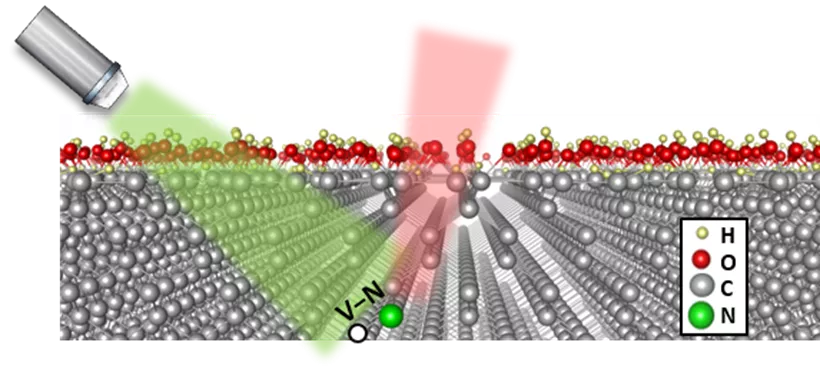Researchers from the HUN-REN Wigner Research Centre for Physics (HUN-REN Wigner RCP) are developing a next-generation quantum microscope in a recently launched project. Their aim is to create a tool with higher spatial resolution and sensitivity than ever before, ready to be used as a quantum sensor by physicists, chemists, biologists, and engineers for examining and classifying various materials. Another recent project at Wigner RCP aims to integrate certain areas of artificial intelligence with those of quantum technology, such as quantum computing and quantum sensing, through which they seek to develop a software package that employs machine learning algorithms and other artificial intelligence-based algorithms to enhance the efficiency of quantum computers.
In the research group led by Ádám Gali, the unique properties of the diamond nitrogen-vacancy centre are used to measure magnetic, electric, and mechanical fields, as well as temperature, with high spatial resolution.

Nitrogen-vacancy centre in diamond, which serves as a quantum sensor, detecting the region above the diamond under appropriate illumination (green light), which can then be optically sensed (red light).
During the project, the researchers plan to use the quantum microscope to implement unique measurement methods such as magnetic resonance detection based on fluorescence lifespan, and fluorescence imaging based on two-photon absorption. To their knowledge, this would be a unique tool in the technology market, as there is currently no quantum sensor combining such components. Also considered a singular solution in Europe is the measurement technique based on the unique nitrogen-vacancy centre, which will be applied in the quantum microscope.
The group plans to develop several types of microscopes. With a simpler and more affordable version, they aim to assist in training professionals, while a more advanced type can be used in the laboratories of universities, research institutes, as well as companies and factories for the examination of various materials in the future. The significant advantage of these tools is that they operate at room temperature, do not require special conditions, and consume low energy.
Another recently initiated project, led by Orsolya Kálmán and Zoltán Zimborás, also serves the development of quantum technology. This time, the researchers aim to integrate certain areas of artificial intelligence with those of quantum technology, such as quantum computing and quantum sensing, through which they seek to develop a software package that employs machine learning algorithms and other artificial intelligence-based algorithms to enhance the efficiency of currently available noisy quantum computers.
Within the project, the researchers also aim to develop algorithms that can enable near-future quantum processors for machine learning and processing data from quantum sensors. The primary goal is to create an artificial intelligence-enhanced quantum gate translator, which incorporates a quantum error-correction procedure as well. Additionally, as a test and potential industrial application, they plan to devise quantum machine learning algorithms that can be amplified through the quantum hardware, as well as the developed translation and error-correction procedures. These algorithms will be tested on both classical simulators and quantum processors.
According to the researchers, the two projects running until 2026 are expected to significantly contribute to quantum technology developments in Hungary and Europe in the fields of scientific and industrial applications.